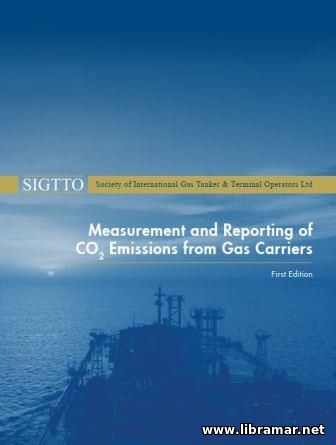 This is one more volume relating to the modern carriers of the liquefied gases. It shall be noted that the guidance provided in the pages of this official SIGTTO publication is intended to cover the CO2 emissions from the LNG carriers and no other greenhouse gases. The authors have focused on the emissions resulting from the combustion of the hydrocarbons during the regular operation of the vessel.
The trainees are expected to possess some very basic understanding of how the LNG carriers operate. Normally, the main and auxiliary engines and boilers will be considered typical sources of the CO2 emissions, together with the IGG, or Inert Gas Generator, and GCU, standing for the Gas Combustion Unit. In turn, the CO2 emissions can be measured using one of two available methods, namely the direct measurement, or measuring the consumption of the fuel on board with subsequent calculation of the CO2 through the so-called carbon emission factor.
The present volume mainly addresses the second method. The fuel consumption on board is usually monitored through the bunker delivery notes, or calculations based on the tank measurements of either fuel tanks or cargo tanks, should the cargo be used as a fuel. In addition to that, this can be evaluated using the flow meters.
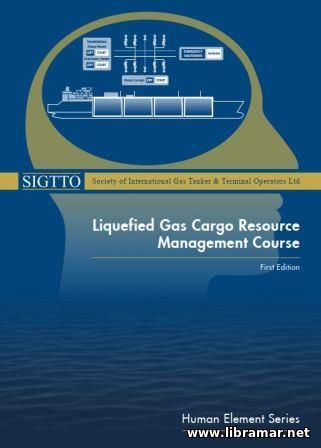 The content of the present Cargo Resource Management course, or CRM for short was developed by the SIGTTO with the ultimate goal to provide necessary help relating to the optimization of the performance of those crew members directly involved in the shipboard cargo activities. The areas covered by the authors include the communication and situational awareness, as well as the proper teamwork and managing the workload of the personnel.
First of all, the readers will get some general information on the planning and further executing cargo operations on board, and then they will proceed to the organization and procedures related to the Cargo Control Room arrangements. The main idea is to make the cargo team behave and work in the maximum effective manner and this is why the ways shall be found to effectively modify the existing relations and make sure that the safest team culture is achieved.
In addition to that, due attention shall be paid to the lessons that have been learned from the incidents occurred in the past, and the critical operations shall be duly identified to move forward. The trainees who have successfully completed the course, will obtain required understanding of the safe and effective cargo handling operations.
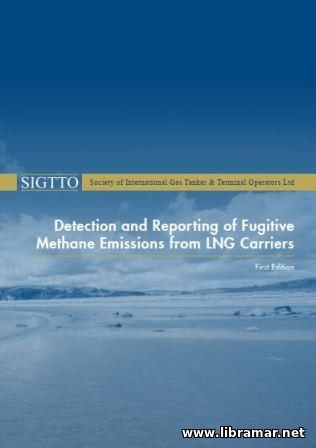 It is the intention of the SIGTTO organization to keep on encouraging the continual improvement in order to significantly reduce the impact that the LNG shipping of today has on the environment. The present publication forms an integral part of the pack of volumes related to the particular environmental issues, supported by the IMO in terms of the GHG reduction.
Since methane is the greenhouse gas, it is critically important to have the reliable systems so that the environmental impact of its carriage gets minimized. The whole idea of the authors of this title was to provide professional recommendation on the identification, detection, measurement and quantification of the fugitive methane emissions from the liquefied gas carriers. The content of the publication perfectly aligns with the principles of the industry that are currently in place.
It goes without saying that once the consistent approach has been duly adopted and implemented, it will seriously contribute to the reduction of the aforementioned emissions. The publication is quite concise but still supplemented with the glossary of terms facilitating the reader-friendliness and helping to better understand the basic principles.
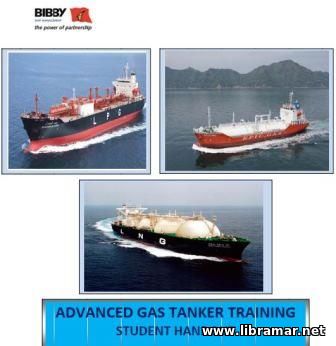 The present introductory course was developed with the intention of the authors to provide the newcomers with the essential information and guidance on the gas tankers. It starts with the general information about the chemical and physical characteristics of the different gases, as well as the hazards associated with their marine transportation.
There is a separate section in the volume devoted to the safety consideration, deservedly considered to be of the utmost importance and therefore must-read to every single crew member. The cargo and gas detection tools have been discussed, as well, together with the cargo calculations.
The readers will get to know about the basic cargo operations that usually take place on board gas tankers. Moreover, they will also get the information about the documentation accompanying every single operation, since they are expected to know and understand the workflow.
We know that the transportation of the liquid cargo may have detrimental effect on the ship stability and trim due to the free surface etc. that is why there is a chapter on this. In addition, the emergency procedures have been explained in detail, including the operation of the shipboard fixed fire extinguishing system.
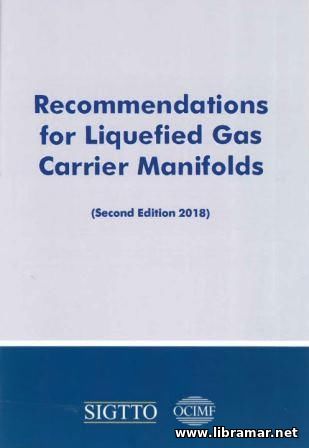 The present document was released to provide the shipping industry with the professional recommendations relating to the arrangement and strength of the manifolds installed on the modern gas carriers, together with the associated fittings. The recommendations contained in this volume have been developed for both LPG and LNG, i.e. liquefied petroleum and natural gases, respectively.
There are seven chapters in this volume, starting with the introduction to the scope of the document and size categories, and followed by the positioning on the manifolds on both types of carriers. The protection from the spillage of cargo has been paid particular attention, including requirements to the height of the coaming, drainage, water curtain etc.
Then there are two chapters dealing with the design, specification and fittings of the manifolds, where you will have information about the carbon and stainless steel manifolds, distance pieces and flanges, spool pieces, reducers etc. you will need to be aware of the additional requirements and you can find them in the sixth chapter, while the closing one is devoted to the bunkering manifolds. There is also a good glossary provided for those not too familiar with the terminology used.
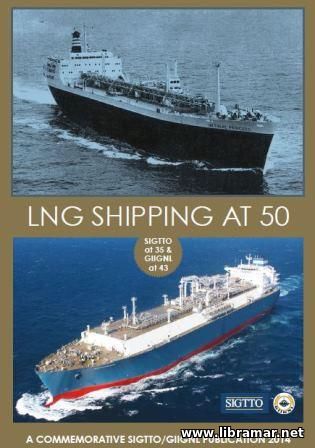 This is a very informative volume developed and released by SIGTTO, one of the most authoritative organizations in the modern maritime shipping world. It opens with some general introduction. Then there is information about the early days of the LPG industry, where the readers will get to know about the trial voyages of the “Methane Pioneer” back in 1959, the “Methane Princess” and “Progress” considered truly exceptional pieces of engineering of those times, cross-Mediterranean trades, containment systems etc.
After that, you will read about the pioneers of the industry, including the key innovators and motivators, shipboard cargo handling appliances, shipbuilding activities in China, South Korea and Japan, etc. The LPG carriers and trade activities are discussed in the next chapters together with the safety regime, including the role played by the SIGTTO in developing the safety record, contents of the IGC Code and its revisions, information about the LPG terminals and other aspects. After going through the info about the middle years and the new millennium, the readers will reach the today of the LPD marine transportation. In short, the document shall be read by all people willing to stay at the edge of the modern technology.
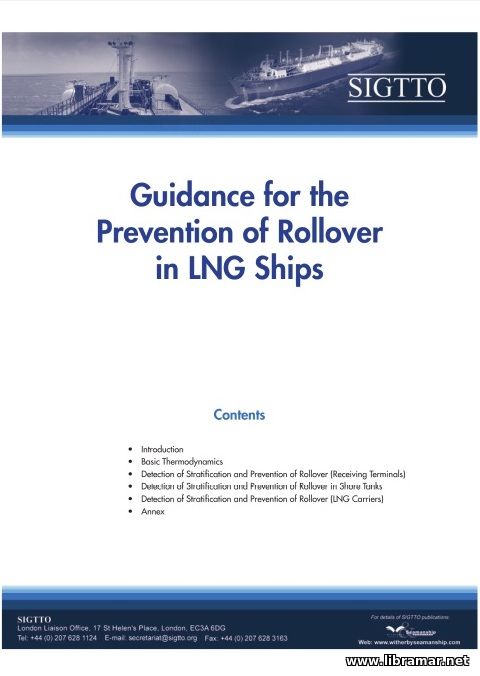 This guidance was produced by SIGTTO to members' concerns about the some of the interpretations of the functional requirements for emergency shutdown systems; in particular, differences between the needs of the liquid natural gases industry and those of liquid petroleum gases industry. It was also aimed to encourage and promote the use of linked emergency shutdown systems at both LPG and LNG terminals, especially where cargo transfer rates are quite high or where they handle one of the cargoes stated in IGC Code 1993/Chapter 17.
However, this SIGTTO publication is not intended to contradict any international or national requirements or standards for operational practices at the liquefied gas ship-shore interface. One of the primary objectives of this guidance was to advise the operators/owners of gas carriers about the rollover-related issues. The rollover itself mainly refers to the quick release if the LNG vapor occurring when the layers of different densities of LNG are spontaneously mixed in a cargo or storage tank. While for the conventional onshore terminals all such issues are known and understood, for LNG vessels the associated circumstances are a bit unusual and have to be paid serious additional attention...
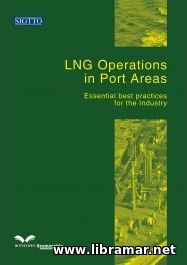 The present document prepared by the specialists of one of the most authoritative entities in the world of maritime shipping has been released with the specific aim to provide required technical guidance to the crew members of the vessels engaged in marine transportation of the natural liquefied gas. The material contained in the book draws on the remarkable experience of the authors, all of them being recognized members and experts of the gas industry.
Their collaboration has eventually resulted in this guidebook explaining the established best practices for the proper management of the shipping operations in the ports. The authors have also illuminated the profile of the risks commonly associated with the gas operations - this information will be useful to the persons administering the ports and providing the essential services.
The publication shall definitely be treated as a very essential guidance for all people dealing with the design, construction and subsequent operation and maintenance of the LNG terminals in the ports as the information contained in its pages can be used when conducting the reassessment of the risks that are subject to frequent changes taking into account the nature of the operations.
|







